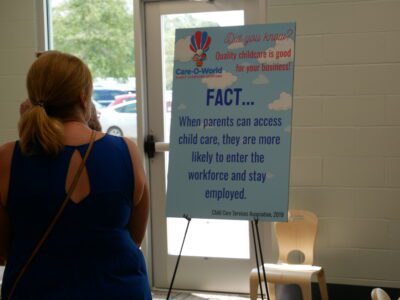

|
|
A new survey of more than 10,000 early childhood educators nationwide reveals that child care is becoming less accessible as federal pandemic-era funding expires.
The National Association for the Education of Young Children (NAEYC) conducted the January 2024 survey that included educators from centers, homes, faith-based programs, Head Start, and public preschool programs in all 50 states and the District of Columbia.
“The loss of federal funds that helped the early childhood sector weather the pandemic has exacerbated long-standing challenges like low wages and high operating costs, leading to staff shortages, program closures, and rising family tuition rates,” said Michelle Kang, CEO of NAEYC. “The results make it clear — significant public investment in child care is needed urgently to ensure programs can retain qualified educators and remain open to serve children and families.”
Federal funds, intended to stabilize child care through the pandemic, expired at the end of September 2023, but North Carolina’s General Assembly took steps to stretch that funding through June 2024. The survey results may be a preview of what North Carolina can expect in the absence of significant public investment when funds dry up this summer.
Staffing shortages
More than half of survey respondents indicated their programs are under-enrolled relative to the capacity of their facilities, reducing the overall availability of child care. The top reason given for this trend was staffing shortages (89%).
“We are struggling because of staff shortages. We have a very long waitlist but cannot get to it because we don’t have enough staff to fill the classrooms,” one North Carolina administrator/director told NAEYC.
Survey respondents in North Carolina report similar rates of under-enrollment as the rest of the country. But 60% of North Carolina respondents indicated their program is experiencing staffing shortages, compared with 53% nationally.
While a report from the Century Foundation warns of a wave of child care program closures — they predict 1,178 closures affecting 155,539 children in North Carolina — the NAEYC survey suggests we should expect less of a sudden wave and more of an ongoing ripple effect.
Closing classrooms or under-enrolling programs reduces the overall availability of child care, while allowing programs to keep their doors open. These changes affect accessibility of child care, but aren’t necessarily captured in statewide data sources that track closures, like the one EdNC is monitoring.
More on the child care crisis
Almost twice as many NAEYC survey respondents reported programs closing in their communities in the last year, compared with those who reported programs opening. This gap was even wider in North Carolina, with 56% reporting program closures and just 21% reporting openings.
The data in North Carolina support these findings. Our state experienced a net loss of child care programs from the third to fourth quarter of 2023, which you can read more about here.
Low wages
The second most common reason given for under-enrollment in early childhood education programs nationally was low wages (77%).
Despite modest increases in wages — from about $12 per hour pre-pandemic to about $14 per hour now — NAEYC found “twice as many respondents said their economic situation had worsened (31%) compared to those who said it improved (16%).”
“You’ve got to have some investment coming from somewhere because people can’t go backward.”
Kristi Snuggs, president of Child Care Services Association
While more than half of survey respondents nationally reported raising wages in the last six months, barely a third of North Carolina respondents reported the same.
The persistence of low wages was one of the main takeaways from the report for Kristi Snuggs, president of Child Care Services Association.
“We’ve invested in North Carolina more than a billion dollars in stabilization grants, and the (average) rate of pay has come up two dollars?” Snuggs said. “I just think it shows how poorly paid the workforce is.”
The survey found that among early childcare educators who were considering leaving the field, higher pay was the factor most likely to keep them in classrooms.
“Staff burnout is real,” a family child care care owner/operator in North Carolina told NAEYC. “Early childhood providers should be respected more; we are essential to the country.”
This reality is reflected in the survey results: 46% of respondents reported increased levels of burnout since January 2023.
Cost increases
The third most common reason respondents gave for under-enrollment (66%) was lack of affordability for families.
Costs for providers are increasing at the exact time that federal funding is winding down. More than one third of respondents reported increases in rent, and more than half reported increases in liability and property insurance rates.
Nationally, 48% of respondents reported raising tuition in the last six months as a way to cover their own costs.
With fixed costs increasing for providers, Snuggs said, “The only thing that they know to do is to increase the cost to parents, and that’s something that just can’t happen.”
Increases in fixed costs are less pronounced in North Carolina, which may explain why tuition increases were less commonly reported (40%) by respondents in our state. But with four months to go before the end of federal funding, tuition increases are already happening here.
“We’ve had lots of (tuition) rate increases, I think we’ve gone up about $250 per kid,” one director/administrator in North Carolina told NAEYC.
Impact of state investment
Facing the loss of federal funding, some states have made their own investments in early childhood education.
NAEYC identified 11 such states, plus the District of Columbia, then compared their survey responses to the rest of the country.
In places that increased public funding for child care, fewer respondents reported raising tuition or that their waitlists had grown in the last six months. That equates to greater availability and affordability of child care in those locations.
Snuggs said this evidence helps make the case for greater public investment in early childhood education. She also pointed to a statewide voter survey conducted by the N.C. Chamber Foundation last year that found nine in 10 North Carolina voters want more state investment in child care.
“I think we can build on that common interest among North Carolinians,” Snuggs said.
Snuggs is optimistic that the General Assembly will respond to that common interest during its short session this year.
“My concern though,” Snuggs said, “is these stopgap measures are going to eventually dry up and we’ve got to find a more permanent way to invest.”








